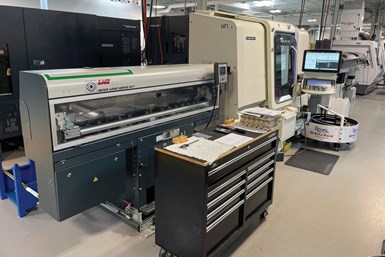Manufacturer Mulls Long Versus Short Bar Feeder
A manufacturer of gears and gear assemblies decided four-foot magazine bar feeders made more sense than 12-foot, single-barrel bar feeders.

As SDP/SI strives toward lights-out machining, it has found that shorter magazine bar feeders (such as this unit from LNS America) rather than longer single-barrel bar feeders enable sufficiently long stretches of unattended machining, while indexable parts collectors (such as the one shown here from Royal Products) automatically accumulate completed parts. Photo Credit: PM
Last year, I visited SDP/SI, a division of Designatronics, to develop this story explaining how the Hicksville, New York, manufacturer of precision gears, gear assemblies and related components for a range of motion control applications has become a more efficient and profitable operation by embracing machining challenges.
During the visit, I learned the company had made the decision to replace 12-foot bar feeders with 4-foot models. A reader asked for more details about this decision, so I followed up with Robert Kufner, SDP/SI president and CEO, to learn more about this decision.
Kufner says the company considered replacing the 12-foot, single-barrel bar feeders with 12-foot magazine bar feeders. However, it was determined that automated, 4-foot magazine bar feeders held enough material to cover roughly 85% of its longest running jobs. This gave the company the option to make a trade for fitting in more machine “cells” on the floor versus having all machines with 12-foot bar feeders.
“The 12-foot bar feeders were overkill and the ROI didn’t make sense to have more bar capacity than we needed,” Kufner says. “For us, it was better to make room for more ‘cells’ for job flexibility. That said, it might make sense for a shop to consider 12-foot magazine bar feeders if the volumes are very high. It didn’t make sense for us.”
Is this a decision you had to make? If so, let me know where you landed on this and why.
SDP/SI was a 2019 winner of sister publication Modern Machine Shop’s Top Shops benchmarking program in the Human Resources category. Learn more about why it was selected. Much of it had to do with eliminating company silos.
Related Content
-
Tips for Troubleshooting and Repairing Chip Conveyors
A nonfunctioning chip conveyor can cause a high-production machine to be down for an extended period of time. Here is some troubleshooting advice if you’re having issues with your chip conveyors.
-
Automation Breakthroughs Revolutionize Precision Machining for Complex Parts
Marubeni Citizen-Cincom delivers custom solutions to address some of the biggest challenges in precision machining from handling small parts, to robot integration and unique tooling needs.
-
Reinventing the Wheel with Robot-Automated CNC Multitasking
One race team discovers how to efficiently manufacture a new wheel nut design for the next-generation NASCAR stock car with the help of a CNC mill/turn and a built-in robot.









.jpg;maxWidth=300;quality=90)



.jpg;maxWidth=300;quality=90)

